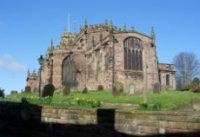 |
Back to WHAT WE DO Churches & Pubs in 2008
|
 |
The New Churches & Pub
Group will meet on the
1st Wednesday of each month starting March 5th 2008.
1st Wednesday of each month starting March 5th 2008.
Programme:-
Please inform Steve Reynolds beforehand if you wish to come on any visit. We need to provide both church & pub with an indication of numbers.
March 5 Church of St. Giles at Cheadle, Staffordshire and the Yew Tree Inn at Cauldon.
Inaugural Outing of the U3A Churches and Pubs Group. (Report click here!)
April 16 St Michael with St Mary, Melbourne and the .Blue Bell (Report click here!)
May 7 St Mary’s Nantwich. Decorated Gothic with 19th century west front by Scott. (afternoon visit at 2pm)
Pub - Bhurtpore at Aston.Indian connection,vast range of beers, curries a speciality.
Meet Village Hall 10am to go straight to pub. (Report click here!)
June 4 St Mary& All Saints,Chesterfield. Decorated/Victorian. Optional climb up crooked spire.
and the Old Pump at Barlow. Long bar with real ale. Meet 9am Village Hall Car Park (Report click here!)
September 3 Joint meeting with the Heritage Group
Gorton Monastery. Tour and Buffet Lunch £10. Limited numbers. Few left. Prebooking is essential.
Meet 10.00am at the village hall to travel by car. For background information click here (Report click here!)
October 15 St Ann's Church, St Ann Street, Manchester, M2 7LF and, if there is time, a quick look at The Hidden Gem (St. Mary's Roman Catholic Church)
Pub - Sam's Chop House Chapel Walks, Manchester, M2 1HN "It’s a meeting place with much more than just beers to drink." Travel Arrangements(to be confirmed), meet outside St Ann’s for an 11am start. (Report click here!)
March 5
Church of St.
Giles at
Cheadle, Staffordshire and the Yew
Tree Inn at Cauldon
Inaugural Outing of the U3A Churches and Pubs Group.
Leader:- Steve Reynolds
Some thirty U3A members set out on the first visit of this new group.
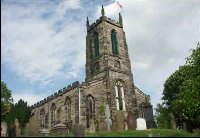 St.
Giles was built to the designs of the architect Augustus Welby Pugin in
the early 1840s and was consecrated on August 31st 1846. The
cost
was borne by the Earl of Shrewsbury, who lived at Alton Towers nearby,
apparently with no expense spared and a free hand for the up-and-coming
24year-old Pugin. The only limitation was that local building
materials and local craftsmen should be employed wherever possible.
St.
Giles was built to the designs of the architect Augustus Welby Pugin in
the early 1840s and was consecrated on August 31st 1846. The
cost
was borne by the Earl of Shrewsbury, who lived at Alton Towers nearby,
apparently with no expense spared and a free hand for the up-and-coming
24year-old Pugin. The only limitation was that local building
materials and local craftsmen should be employed wherever possible.
The result was a church interior recalling the cheerful decorative style of the old medieval churches, except that cheerfulness became exuberance under Pugin’s direction and coloured motifs covered almost every available space on the walls. It must have made a sensational impact on the people of the mid-nineteenth century and it continues to impress today.
St. Giles is, without doubt, a unique church and would repay a visit by anyone interested in church design and architecture.
Our guide for the visit was Mr. Peter Cartledge ( assisted by his wife Doreen ) who has been associated with the church all his life, having begun serving as an altar boy at the age of eight. He gave us a detailed description of the church and its history plus some wry comments about people who had been involved in the life of the church.
 The Yew Tree Inn , Cauldon, is an
unremarkable building, idyllically situated between a quarry and a
cement works. On
entering, the first impression is of a cross between a museum and a
junk shop and this impression remains up to the time of leaving.
Nevertheless, this public house has received several
accolades
from consumer organisations as being a place which people like to visit
without much regard for the usual standards of acceptability.
The Yew Tree Inn , Cauldon, is an
unremarkable building, idyllically situated between a quarry and a
cement works. On
entering, the first impression is of a cross between a museum and a
junk shop and this impression remains up to the time of leaving.
Nevertheless, this public house has received several
accolades
from consumer organisations as being a place which people like to visit
without much regard for the usual standards of acceptability.
Among the identifiable artefacts on display are farm implements, animal traps, numerous ancient guns and a few spears. The second-hand seating has obviously seen better days in much grander establishments.
At least eight ‘Polyphons’ – clockwork musical boxes - using large perforated metal discs – are hung on the walls and will still play a tune on insertion of a 2p coin. There is also a collection of old valve-operated radio receivers. This is undeniably a pub with “character” – of a sort.
However, the hospitality of the house was excellent. An attractive buffet meal had been laid out for us on our arrival and we were further delighted to find that the price of drinks at the bar was surprisingly low.
Our lunch provided a satisfying and convivial end to an enjoyable, informative and undoubtedly successful first excursion with the Churches and Pubs Group, for which we can be grateful to Steve, who sent us on our homeward way with his virtuoso performance on the pub’s pianola ringing in our ears.
This project holds a lot of promise. Watch this space. Fred Sleigh
April 16 St Michael with St Mary, Melbourne and the .Blue Bell
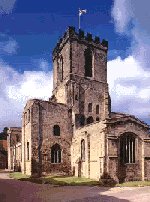 Our
arrival in the ‘courtyard’ of Melbourne Parish Church was a surprise. We
seemed to have stepped back into another century. This grand,
tall church stands proudly in the midst of old houses and alongside
Melbourne Hall (Lord Melbourne, Queen Victoria’s first Prime
Minister, gave his name in 1837 to a small Australian Settlement which
is now a great city). A stroll around the exterior revealed huge doors
beautifully preserved.
Our
arrival in the ‘courtyard’ of Melbourne Parish Church was a surprise. We
seemed to have stepped back into another century. This grand,
tall church stands proudly in the midst of old houses and alongside
Melbourne Hall (Lord Melbourne, Queen Victoria’s first Prime
Minister, gave his name in 1837 to a small Australian Settlement which
is now a great city). A stroll around the exterior revealed huge doors
beautifully preserved.
On entering the church I instantly became aware of spaciousness, height and light. There is limited stained glass but what there is is stunning. Light, clean stone and vast solid pillars lead your eyes to the row of
windows in the clerestary. The vicar, the Rev. Dr. John
Davies, greeted us and gave a
fascinating insight into the history of this lovely church made of
local stone around 1120/30 in Norman times. The Normans
brought
their own style of architecture and religion. The church has
stood the test of time and because there has never been a family
connection has remained as it was and retained its Norman character (in
the Vicar’s words “it escaped being
Victorianised”.) There are so many interesting
features,
minor altars and chapels and a unique King’s
Gallery. A
peel of 12 bells (the heaviest 15.5 cwt.) in front of the altar
–
definitely worth another visit (the church is open every day).
the row of
windows in the clerestary. The vicar, the Rev. Dr. John
Davies, greeted us and gave a
fascinating insight into the history of this lovely church made of
local stone around 1120/30 in Norman times. The Normans
brought
their own style of architecture and religion. The church has
stood the test of time and because there has never been a family
connection has remained as it was and retained its Norman character (in
the Vicar’s words “it escaped being
Victorianised”.) There are so many interesting
features,
minor altars and chapels and a unique King’s
Gallery. A
peel of 12 bells (the heaviest 15.5 cwt.) in front of the altar
–
definitely worth another visit (the church is open every day).
Sadly no time to explore the village. However we retired to the Blue Bell Inn where the staff ‘fed and watered’ us well.
Thanks Steve for another successful visit. Betty Upham
May 7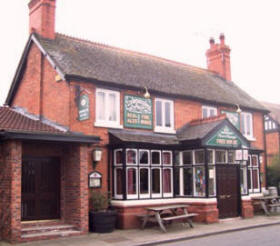 Bhurtpore at Aston
and St Mary’s, Nantwich.
Bhurtpore at Aston
and St Mary’s, Nantwich.
.It was a beautiful day for our trip to the Bhurtpore Inn in Aston and then to St. Mary’s in Nantwich. The Bhurtpore specializes in Indian curries which most of our group had and thoroughly enjoyed.
After a leisurely lunch we headed to the parish church of St. Mary’s, which is considered to be one of Britain’s finest Medieval town churches dominating the centre of Nantwich. Built of Cheshire red sandstone it is a magnificent example of 14th Century architecture and several mason’s marks are clearly visible on the inside walls.
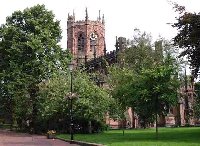 On
our arrival we were greeted by Ray who then introduced us to David and
Harold, who were our very knowledgeable and witty guides. In the nave
of the church are many stained glass windows. Situated in the North
aisle is the newest stained glass called the "Creation" window, given
in 1984 by Mrs Elizabeth Bourne in memory of her husband Albert, a
local farmer. The farmer himself is shown twice, fishing in the stream
and on the opposite side, emerging from the trees with his gun and dog.
The lower section of the window shows the farmer's house with creatures
of the Cheshire Plain. Above are shown some animals of the world, birds
of the air and fishes of the sea, star and heavenly bodies including
Halley's comet - all beneath the hand of the creator. The
window
was designed by Michael Farrar-Bell.
On
our arrival we were greeted by Ray who then introduced us to David and
Harold, who were our very knowledgeable and witty guides. In the nave
of the church are many stained glass windows. Situated in the North
aisle is the newest stained glass called the "Creation" window, given
in 1984 by Mrs Elizabeth Bourne in memory of her husband Albert, a
local farmer. The farmer himself is shown twice, fishing in the stream
and on the opposite side, emerging from the trees with his gun and dog.
The lower section of the window shows the farmer's house with creatures
of the Cheshire Plain. Above are shown some animals of the world, birds
of the air and fishes of the sea, star and heavenly bodies including
Halley's comet - all beneath the hand of the creator. The
window
was designed by Michael Farrar-Bell.
The wonderful carved pulpit was designed by Thomas Finch in 1601. The kneelers are the work of St. Mary’s tapestry group and each pew has a different theme. The tapestry kneelers are very colourful and attract a lot of visitors from all over the world.
In the chancel is a richly canopied sedilla, with many wonderful wooden carvings and we could have spent a longer time looking at them.
The Jubilee curtain impressed us all. It was designed by Denise Bates and embroidered by the ladies of St. Mary’s.
There was so much to see that the time flew by and before we knew it, it was time for us to leave.
Our thanks go to Steve for all his hard work and for such an enjoyable day. We look forward to Chesterfield. Paul Kenneth
June 4 St Mary& All Saints and the Old Pump at Barlow.
 Chesterfield
parish church's wonky spire became famously twisted and bent in sheer
surprise when a bride turned out to be a virgin on her wedding day, so
the old story goes. Another myth insists the devil became enraged at a
clumsy shoeing job on his hooves and clobbered the spire with his tail.
Chesterfield
parish church's wonky spire became famously twisted and bent in sheer
surprise when a bride turned out to be a virgin on her wedding day, so
the old story goes. Another myth insists the devil became enraged at a
clumsy shoeing job on his hooves and clobbered the spire with his tail.
More mundanely, it's probable that Bob the medieval builder skimped on the materials, which promptly warped and woofed, put a squiggle in the spire and made Chesterfield's fortune in the tourist industry.
Thirty five of us turned up to tour the Church of Our Lady and All Saints (mysteriously, 36 later sat down for lunch and no, the latecomer was not Old Nick) but not all made it up the squeezebelly spiral stairs to the base of the tower. Those who did were treated to fabulous views on every side because the church sits in a wide, shallow depression.
Interestingly, the lead-covered, oak framed spire also simply plonks its 200-ton weight on the stone tower, like a boiled egg in an egg-cup -- no bolts to hold it down, no superglue, no zip fasteners, just its own weight preventing it from blowing away.
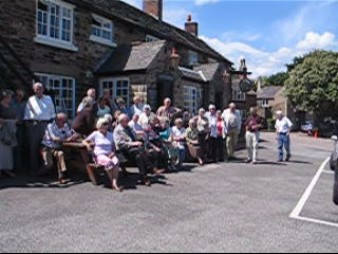 An
excellent lunch
at the Old Pump at Barlow demonstrated the way successful British pubs
are moving to the heights of the better sort of French village caff.
An
excellent lunch
at the Old Pump at Barlow demonstrated the way successful British pubs
are moving to the heights of the better sort of French village caff.
Cue for an old Bernard Manning joke.
British diner perusing menu in Parisian resturant: 'Garcon, have you got frogs' legs'?
Waiter: 'Oui monsieur'.
Diner: 'Well hop off to the kitchen and get me pie and chips'!
How things have changed for the better.
The hugely enjoyable outing was plotted, planned and persecuted by Steve Reynolds' Worldwide Mega Productions for High Lane U3A. Tony Holt
Please inform Steve Reynolds beforehand if you wish to come on any visit. We need to provide both church & pub with an indication of numbers.
March 5 Church of St. Giles at Cheadle, Staffordshire and the Yew Tree Inn at Cauldon.
Inaugural Outing of the U3A Churches and Pubs Group. (Report click here!)
April 16 St Michael with St Mary, Melbourne and the .Blue Bell (Report click here!)
May 7 St Mary’s Nantwich. Decorated Gothic with 19th century west front by Scott. (afternoon visit at 2pm)
Pub - Bhurtpore at Aston.Indian connection,vast range of beers, curries a speciality.
Meet Village Hall 10am to go straight to pub. (Report click here!)
June 4 St Mary& All Saints,Chesterfield. Decorated/Victorian. Optional climb up crooked spire.
and the Old Pump at Barlow. Long bar with real ale. Meet 9am Village Hall Car Park (Report click here!)
July
2
St
Oswald,
Malpas.
Perpendicular with 2 super chapels dedicated to
the Cholmondeley & Brereton families
Pub - Cholmondeley Arms, Bickley Moss. Old school
house,good food. (Report
click here!) September 3 Joint meeting with the Heritage Group
Gorton Monastery. Tour and Buffet Lunch £10. Limited numbers. Few left. Prebooking is essential.
Meet 10.00am at the village hall to travel by car. For background information click here (Report click here!)
October 15 St Ann's Church, St Ann Street, Manchester, M2 7LF and, if there is time, a quick look at The Hidden Gem (St. Mary's Roman Catholic Church)
Pub - Sam's Chop House Chapel Walks, Manchester, M2 1HN "It’s a meeting place with much more than just beers to drink." Travel Arrangements(to be confirmed), meet outside St Ann’s for an 11am start. (Report click here!)
Inaugural Outing of the U3A Churches and Pubs Group.
Leader:- Steve Reynolds
Some thirty U3A members set out on the first visit of this new group.
 St.
Giles was built to the designs of the architect Augustus Welby Pugin in
the early 1840s and was consecrated on August 31st 1846. The
cost
was borne by the Earl of Shrewsbury, who lived at Alton Towers nearby,
apparently with no expense spared and a free hand for the up-and-coming
24year-old Pugin. The only limitation was that local building
materials and local craftsmen should be employed wherever possible.
St.
Giles was built to the designs of the architect Augustus Welby Pugin in
the early 1840s and was consecrated on August 31st 1846. The
cost
was borne by the Earl of Shrewsbury, who lived at Alton Towers nearby,
apparently with no expense spared and a free hand for the up-and-coming
24year-old Pugin. The only limitation was that local building
materials and local craftsmen should be employed wherever possible.The result was a church interior recalling the cheerful decorative style of the old medieval churches, except that cheerfulness became exuberance under Pugin’s direction and coloured motifs covered almost every available space on the walls. It must have made a sensational impact on the people of the mid-nineteenth century and it continues to impress today.
St. Giles is, without doubt, a unique church and would repay a visit by anyone interested in church design and architecture.
Our guide for the visit was Mr. Peter Cartledge ( assisted by his wife Doreen ) who has been associated with the church all his life, having begun serving as an altar boy at the age of eight. He gave us a detailed description of the church and its history plus some wry comments about people who had been involved in the life of the church.
 The Yew Tree Inn , Cauldon, is an
unremarkable building, idyllically situated between a quarry and a
cement works. On
entering, the first impression is of a cross between a museum and a
junk shop and this impression remains up to the time of leaving.
Nevertheless, this public house has received several
accolades
from consumer organisations as being a place which people like to visit
without much regard for the usual standards of acceptability.
The Yew Tree Inn , Cauldon, is an
unremarkable building, idyllically situated between a quarry and a
cement works. On
entering, the first impression is of a cross between a museum and a
junk shop and this impression remains up to the time of leaving.
Nevertheless, this public house has received several
accolades
from consumer organisations as being a place which people like to visit
without much regard for the usual standards of acceptability.Among the identifiable artefacts on display are farm implements, animal traps, numerous ancient guns and a few spears. The second-hand seating has obviously seen better days in much grander establishments.
At least eight ‘Polyphons’ – clockwork musical boxes - using large perforated metal discs – are hung on the walls and will still play a tune on insertion of a 2p coin. There is also a collection of old valve-operated radio receivers. This is undeniably a pub with “character” – of a sort.
However, the hospitality of the house was excellent. An attractive buffet meal had been laid out for us on our arrival and we were further delighted to find that the price of drinks at the bar was surprisingly low.
Our lunch provided a satisfying and convivial end to an enjoyable, informative and undoubtedly successful first excursion with the Churches and Pubs Group, for which we can be grateful to Steve, who sent us on our homeward way with his virtuoso performance on the pub’s pianola ringing in our ears.
This project holds a lot of promise. Watch this space. Fred Sleigh
April 16 St Michael with St Mary, Melbourne and the .Blue Bell
 Our
arrival in the ‘courtyard’ of Melbourne Parish Church was a surprise. We
seemed to have stepped back into another century. This grand,
tall church stands proudly in the midst of old houses and alongside
Melbourne Hall (Lord Melbourne, Queen Victoria’s first Prime
Minister, gave his name in 1837 to a small Australian Settlement which
is now a great city). A stroll around the exterior revealed huge doors
beautifully preserved.
Our
arrival in the ‘courtyard’ of Melbourne Parish Church was a surprise. We
seemed to have stepped back into another century. This grand,
tall church stands proudly in the midst of old houses and alongside
Melbourne Hall (Lord Melbourne, Queen Victoria’s first Prime
Minister, gave his name in 1837 to a small Australian Settlement which
is now a great city). A stroll around the exterior revealed huge doors
beautifully preserved.On entering the church I instantly became aware of spaciousness, height and light. There is limited stained glass but what there is is stunning. Light, clean stone and vast solid pillars lead your eyes to
 the row of
windows in the clerestary. The vicar, the Rev. Dr. John
Davies, greeted us and gave a
fascinating insight into the history of this lovely church made of
local stone around 1120/30 in Norman times. The Normans
brought
their own style of architecture and religion. The church has
stood the test of time and because there has never been a family
connection has remained as it was and retained its Norman character (in
the Vicar’s words “it escaped being
Victorianised”.) There are so many interesting
features,
minor altars and chapels and a unique King’s
Gallery. A
peel of 12 bells (the heaviest 15.5 cwt.) in front of the altar
–
definitely worth another visit (the church is open every day).
the row of
windows in the clerestary. The vicar, the Rev. Dr. John
Davies, greeted us and gave a
fascinating insight into the history of this lovely church made of
local stone around 1120/30 in Norman times. The Normans
brought
their own style of architecture and religion. The church has
stood the test of time and because there has never been a family
connection has remained as it was and retained its Norman character (in
the Vicar’s words “it escaped being
Victorianised”.) There are so many interesting
features,
minor altars and chapels and a unique King’s
Gallery. A
peel of 12 bells (the heaviest 15.5 cwt.) in front of the altar
–
definitely worth another visit (the church is open every day).Sadly no time to explore the village. However we retired to the Blue Bell Inn where the staff ‘fed and watered’ us well.
Thanks Steve for another successful visit. Betty Upham
May 7
 Bhurtpore at Aston
and St Mary’s, Nantwich.
Bhurtpore at Aston
and St Mary’s, Nantwich. .It was a beautiful day for our trip to the Bhurtpore Inn in Aston and then to St. Mary’s in Nantwich. The Bhurtpore specializes in Indian curries which most of our group had and thoroughly enjoyed.
After a leisurely lunch we headed to the parish church of St. Mary’s, which is considered to be one of Britain’s finest Medieval town churches dominating the centre of Nantwich. Built of Cheshire red sandstone it is a magnificent example of 14th Century architecture and several mason’s marks are clearly visible on the inside walls.
 On
our arrival we were greeted by Ray who then introduced us to David and
Harold, who were our very knowledgeable and witty guides. In the nave
of the church are many stained glass windows. Situated in the North
aisle is the newest stained glass called the "Creation" window, given
in 1984 by Mrs Elizabeth Bourne in memory of her husband Albert, a
local farmer. The farmer himself is shown twice, fishing in the stream
and on the opposite side, emerging from the trees with his gun and dog.
The lower section of the window shows the farmer's house with creatures
of the Cheshire Plain. Above are shown some animals of the world, birds
of the air and fishes of the sea, star and heavenly bodies including
Halley's comet - all beneath the hand of the creator. The
window
was designed by Michael Farrar-Bell.
On
our arrival we were greeted by Ray who then introduced us to David and
Harold, who were our very knowledgeable and witty guides. In the nave
of the church are many stained glass windows. Situated in the North
aisle is the newest stained glass called the "Creation" window, given
in 1984 by Mrs Elizabeth Bourne in memory of her husband Albert, a
local farmer. The farmer himself is shown twice, fishing in the stream
and on the opposite side, emerging from the trees with his gun and dog.
The lower section of the window shows the farmer's house with creatures
of the Cheshire Plain. Above are shown some animals of the world, birds
of the air and fishes of the sea, star and heavenly bodies including
Halley's comet - all beneath the hand of the creator. The
window
was designed by Michael Farrar-Bell.The wonderful carved pulpit was designed by Thomas Finch in 1601. The kneelers are the work of St. Mary’s tapestry group and each pew has a different theme. The tapestry kneelers are very colourful and attract a lot of visitors from all over the world.
In the chancel is a richly canopied sedilla, with many wonderful wooden carvings and we could have spent a longer time looking at them.
The Jubilee curtain impressed us all. It was designed by Denise Bates and embroidered by the ladies of St. Mary’s.
There was so much to see that the time flew by and before we knew it, it was time for us to leave.
Our thanks go to Steve for all his hard work and for such an enjoyable day. We look forward to Chesterfield. Paul Kenneth
June 4 St Mary& All Saints and the Old Pump at Barlow.
 Chesterfield
parish church's wonky spire became famously twisted and bent in sheer
surprise when a bride turned out to be a virgin on her wedding day, so
the old story goes. Another myth insists the devil became enraged at a
clumsy shoeing job on his hooves and clobbered the spire with his tail.
Chesterfield
parish church's wonky spire became famously twisted and bent in sheer
surprise when a bride turned out to be a virgin on her wedding day, so
the old story goes. Another myth insists the devil became enraged at a
clumsy shoeing job on his hooves and clobbered the spire with his tail.More mundanely, it's probable that Bob the medieval builder skimped on the materials, which promptly warped and woofed, put a squiggle in the spire and made Chesterfield's fortune in the tourist industry.
Thirty five of us turned up to tour the Church of Our Lady and All Saints (mysteriously, 36 later sat down for lunch and no, the latecomer was not Old Nick) but not all made it up the squeezebelly spiral stairs to the base of the tower. Those who did were treated to fabulous views on every side because the church sits in a wide, shallow depression.
Interestingly, the lead-covered, oak framed spire also simply plonks its 200-ton weight on the stone tower, like a boiled egg in an egg-cup -- no bolts to hold it down, no superglue, no zip fasteners, just its own weight preventing it from blowing away.
 An
excellent lunch
at the Old Pump at Barlow demonstrated the way successful British pubs
are moving to the heights of the better sort of French village caff.
An
excellent lunch
at the Old Pump at Barlow demonstrated the way successful British pubs
are moving to the heights of the better sort of French village caff.Cue for an old Bernard Manning joke.
British diner perusing menu in Parisian resturant: 'Garcon, have you got frogs' legs'?
Waiter: 'Oui monsieur'.
Diner: 'Well hop off to the kitchen and get me pie and chips'!
How things have changed for the better.
The hugely enjoyable outing was plotted, planned and persecuted by Steve Reynolds' Worldwide Mega Productions for High Lane U3A. Tony Holt
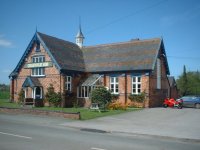
Church - St
Oswald,
Malpas.
Perpendicular with 2 super chapels dedicated to the Cholmondeley & Brereton families
Perpendicular with 2 super chapels dedicated to the Cholmondeley & Brereton families
Old school house,good food.
September 3 Joint meeting with the Heritage Group
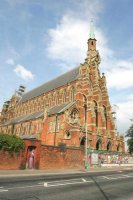
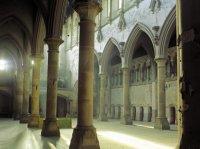
Visit to Gorton Monastery. Tour and Buffet Lunch £10.
Limited numbers. Few left. Prebooking is essential.
For background information click here
Top of Page
 38
members of the Churches & Pubs Group were met at St
Ann’s by
the Rector Nigel Ashworth and his Verger Paul Campion.
38
members of the Churches & Pubs Group were met at St
Ann’s by
the Rector Nigel Ashworth and his Verger Paul Campion. The church was consecrated in 1712 and gets its name from the monarch of the time, Queen Ann & its founder, Lady Ann Bland. The Grade 1 listed building was built with Collyhurst stone and is pink/mauve in colour, the architect was one John Barker. You would never realise it but there is a churchyard,although long since paved over, & St Ann’s is one of very few city centre churches with tombs on display outside.
The interior is strongly protestant with Tuscan columns supporting the galleries. The pulpit was originally centrally placed but was too dominant, so has been moved & at the same time sunk several feet into the floor. The pews are interesting in that several of them have numbers or names. This really went against the spirit of the Church which was to encourage access to all and to sit anywhere in the nave.
The outstanding window in the Church is on the north side and was painted by William Peckitt of York in 1769, although not installed at St Ann’s until 1981. It depicts the apostles Peter John & James and has wonderful vibrant colours.
The Church has a very strong musical tradition which the current Director of Music, Ronald Frost has done much to maintain and enhance, so the organ attracted great interest as did the imposing Steinway piano.
All in all,a very enjoyable,informative and interesting visit to one of Manchester’s iconic buildings.
 We
then paid a short visit to St Mary’s in Mulberry Street (the
Hidden Gem of Manchester). No guided tour here but members
were
able to see the marked contrast between the interior here and
St
Ann’s.
We
then paid a short visit to St Mary’s in Mulberry Street (the
Hidden Gem of Manchester). No guided tour here but members
were
able to see the marked contrast between the interior here and
St
Ann’s.There’s no doubt that Norman Adams’s famous Stations of the Cross are visually stunning even if they are not to everyone’s catholic taste.
 Then
it was time to adjourn to Sam’s Chop House in Chapel Walks
for a
well-earned lunch. Plenty of city centre atmosphere here
& a
very pleasant end to our final visit in 2008. Stephen didn’t
let
us go however, without first handing out his end of year quiz covering
all our visits during the year.
Then
it was time to adjourn to Sam’s Chop House in Chapel Walks
for a
well-earned lunch. Plenty of city centre atmosphere here
& a
very pleasant end to our final visit in 2008. Stephen didn’t
let
us go however, without first handing out his end of year quiz covering
all our visits during the year. Ann Reynolds
